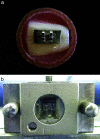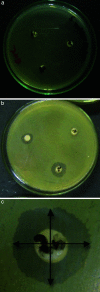Can we add chlorhexidine into glass ionomer cements for band cementation?
- PMID: 21299380
- PMCID: PMC8923563
- DOI: 10.2319/090310-518.1
Can we add chlorhexidine into glass ionomer cements for band cementation?
Abstract
Objective: To test if the addition of chlorhexidine digluconate (CHD) might influence the mechanical properties and antibacterial properties of two different conventional glass ionomer cements (GICs) used for band cementation.
Materials and methods: Two commercial brands of conventional GICs were used: Ketac Cem Easymix (3M/ESPE, St Paul, Minn) and Meron (Voco, Cuxhaven, Germany). The cements were manipulated in their original composition and also with 10% and 18% CHD in the liquid to create a total of six groups. Diametral tensile strength, compressive strength, microhardness, shear bond strength, and antibacterial effects in 5, 45, and 65 days against Streptococcus mutans were tested in all groups, and the data were submitted to statistical analyses.
Results: There were no significant differences between the groups of the same material in diametral tensile, compressive strength, and shear bond strength (P > .05). There was significant improvement in the microhardness to the Ketac Cem Easymix (P < .001). GICs with the addition of CHD showed significant inhibition of S. mutans growth in comparison with the control groups at the three time points evaluated (P < .001). The addition of 18% CHD resulted in higher bacterial inhibition (P < .001).
Conclusions: The addition of chlorhexidine digluconate to conventional GICs does not negatively modify the mechanical properties and may increase the antibacterial effects around the GICs even for relatively long periods of time.
Figures


References
-
- Cacciafesta V, Sfondrini M. F, Stifanelli P, Scribante A, Klersy C. Effect of chlorhexidine application on shear bond strength of brackets bonded with a resin-modified glass ionomer. Am J Orthod Dentofacial Orthop. 2006;129:273–276. - PubMed
-
- Hallgren A, Oliveby A, Twetman S. Fluoride concentration in plaque adjacent to orthodontic appliances retained with glass ionomer cement. Caries Res. 1993;27:51–54. - PubMed
-
- Matalon S, Slutsky H, Weiss E. I. Antibacterial properties of 4 orthodontic cements. Am J Orthod Dentofacial Orthop. 2005;127:56–63. - PubMed
-
- Millett D. T, Doubleday B, Alatsaris M, Love J. Chlorhexidine-modified glass ionomer for band cementation? An in vitro study. J Orthod. 2005;32:36–42. - PubMed
-
- Sanders B. J, Gregory R. L, Moore K, Avery D. R. Antibacterial and physical properties of resin modified glass-ionomers combined with chlorhexidine. J Oral Rehabil. 2002;29:553–558. - PubMed
MeSH terms
Substances
LinkOut - more resources
Full Text Sources
Molecular Biology Databases

